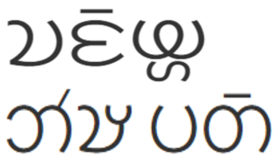Ojhapath
alphasyllabaire
L’ojhapath (ou chakma, changma) est un alphasyllabaire utilisé pour écrire la langue changma kodha ou le pali. La transcription des mots peut faire apparaître de nombreuses différences d’orthographe. Le dessin des lettres est très proche de l’alphabet birman.
| Ojhapath (ou chakma, changma) | |

| |
| Caractéristiques | |
|---|---|
| Type | Alphasyllabaire |
| Langue(s) | Changma kodha |
| Historique | |
| Système(s) parent(s) | Protosinaïtique Phénicien |
| Codage | |
| Unicode | U+11100 à U+1114F |
| ISO 15924 | Cakm[1]
|
| modifier |
|
Représentation informatique
modifierLa plage de caractères Unicode prévue pour l'ojhapath s'étend de U+11100 à U+1114F.
| en fr | 0 | 1 | 2 | 3 | 4 | 5 | 6 | 7 | 8 | 9 | A | B | C | D | E | F |
|---|---|---|---|---|---|---|---|---|---|---|---|---|---|---|---|---|
| U+11100 | 𑄇𑄀 | 𑄇𑄁 | 𑄇𑄂 | 𑄃 | 𑄄 | 𑄅 | 𑄆 | 𑄇 | 𑄈 | 𑄉 | 𑄊 | 𑄋 | 𑄌 | 𑄍 | 𑄎 | 𑄏 |
| U+11110 | 𑄐 | 𑄑 | 𑄒 | 𑄓 | 𑄔 | 𑄕 | 𑄖 | 𑄗 | 𑄘 | 𑄙 | 𑄚 | 𑄛 | 𑄜 | 𑄝 | 𑄞 | 𑄟 |
| U+11120 | 𑄠 | 𑄡 | 𑄢 | 𑄣 | 𑄤 | 𑄥 | 𑄦 | 𑄇𑄧 | 𑄇𑄨 | 𑄇𑄩 | 𑄇𑄪 | 𑄇𑄫 | 𑄇𑄬 | 𑄇𑄭 | 𑄇𑄮 | 𑄇𑄯 |
| U+11130 | 𑄇𑄰 | 𑄇𑄱 | 𑄇𑄲 | 𑄇𑄳 | 𑄇𑄴 | 𑄶 | 𑄷 | 𑄸 | 𑄹 | 𑄺 | 𑄻 | 𑄼 | 𑄽 | 𑄾 | 𑄿 | |
| U+11140 | 𑅀 | 𑅁 | 𑅂 | 𑅃 | 𑅄 | 𑄇𑅅 | 𑄇𑅆 | 𑅇 | ||||||||
- Voir aussi : Table des caractères Unicode/U11100
Le code ISO 15924 du ojhapath est Cakm.
Références
modifier- Consortium Unicode, « Codes pour la représentation des noms d’écritures », (consulté le )
Bibliographie
modifier- (en) Bivuti Chakma et Andrew Glass, Proposal to encode CHAKMA LETTER LHAA, DEPENDENT VOWEL SIGNS AA & EI for Chakma (no L2/16-330), (lire en ligne)
- (en) Michael Everson, Preliminary proposal for encoding the Chakma script in the UCS (no N3428, L2/08-133), (lire en ligne)
- (en) Michael Everson et Martin Hosken, Proposal for encoding the Chakma script in the UCS (no N3645R, L2/09-187R), (lire en ligne)
- (en) Zachary Scheuren, Proposal to encode CHAKMA LETTER VAA for Pali (no L2/19-143), (lire en ligne)